Pit vipers are some of the most diverse snakes that come in pretty much every color of the rainbow. Yet, have you tried to compare the size of a pit viper to, say, a park bench or your friend’s pickup truck?
Rattlesnakes are the best-known pit viper, but they’re not the only ones you can find!
The term pit viper may sound like something scary, conjuring odd nightmares of being stuck in a pit with a fighting viper. However, the truth is far less terrifying. Pit vipers are venomous snakes with an added heat-sensing organ located between and just a little below their eye and nostril on each side, called a loreal pit because of its location on the loreal scale, which gives them their name. They are some of the most advanced snakes to ever evolve, and scientists believe they are far newer than most other snake species.
They’re also the most numerous group of venomous snakes in the Viperidae family, with somewhere around 280 species. Pit vipers range from tiny little sidewinders and Mao-Lan pit vipers to huge bushmasters and eastern diamondback rattlesnakes.
Just how big do they get? Let’s find out!
Water Moccasin (Agkistrodon piscivorus)
Also called cottonmouths, water moccasins are cranky pit vipers that don’t usually take off when you encounter them. Instead, these large semiaquatic pit vipers coil up and show off their cotton-white mouths as a threat display. This makes people think they’re aggressive. However, unless they’re striking they just don’t move all that fast and would rather intimidate you.
Although these snakes are not 11-foot beasts like the bushmaster, when a big one comes in at just under six feet long, they are not tiny! That’s a lot of snake with some potent venom. To compare this snake’s size, imagine a six-foot dog leash stretched out — that’s how long a cottonmouth can get.
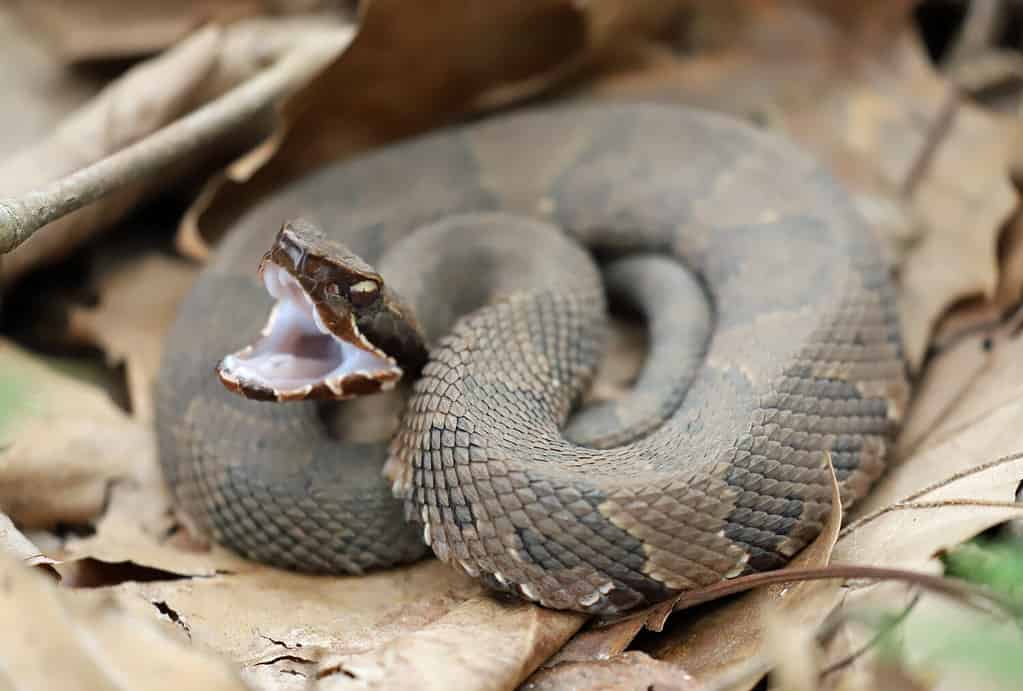
Cottonmouths gape their mouths wide open, showing the white lining of their mouths.
©KF2017/Shutterstock.com
Jararacussu (Bothrops Jararacussu)
Close cousins to the Jararaca, this snake is big. Like most of its South American relatives, it is thick-bodied and very stout. Jararacussu snakes live in coastal Brazil, Paraguay, southeastern Bolivia, with a small slip of population in northeastern Argentina.
The species can be active any time, day or night! If the weather is cooler, they’re out during the day. However, when the weather gets really hot, they’re likely to switch to nocturnal habits. Because snakes can’t self-regulate their body temperatures the way mammals can, they’re reliant upon the ambient temperature and basking in the sun for heat. While many other snakes, probably most, try to avoid confrontation, the jararacussu will stand their ground and are more prone to biting.
Jararacussu can grow to over seven feet long. That’s longer than a typical doorway is tall and almost as long as two park benches side-by-side. There isn’t much published data on their weight, but a good bet is that they probably weigh around 15 pounds.
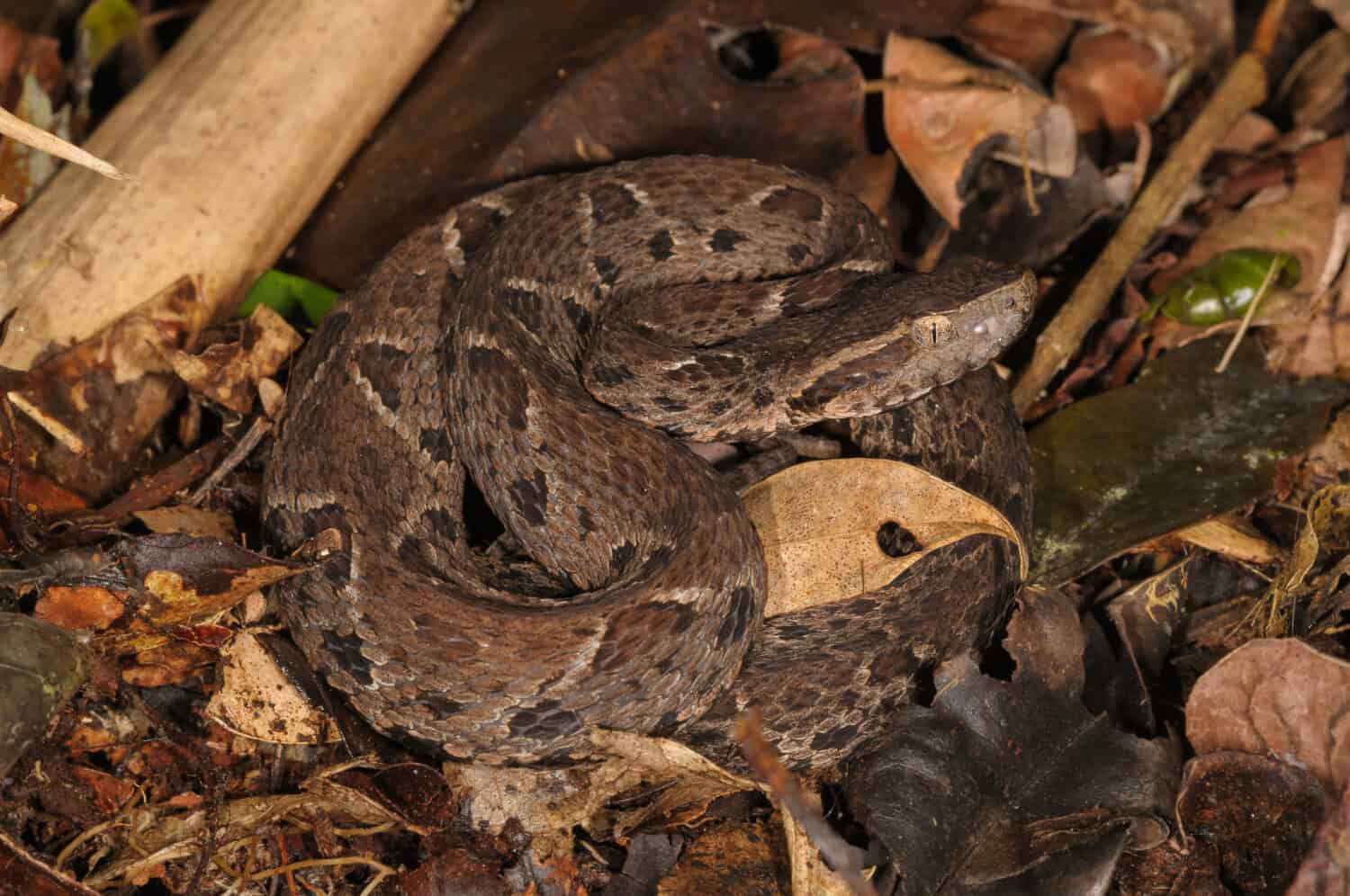
The jararacussu is a close cousin to the jararaca that gets a bit bigger.
©Celso Margraf/Shutterstock.com
Habu (Protobothrops flavoviridis)
Native to the Ryuku Islands of Japan, the habu is a dangerous pit viper. Their venom is a toxic cocktail that causes nausea, vomiting, blood pressure drops, and death. However, even though there are two bites per 1,000 people, the fatalities are less than one percent.
Habus are terrestrial, often entering homes and other buildings looking for rats and mice. This snake is more irritable than some species and prone to biting.
Most habus average between four and five feet long. However, they can grow to nearly eight feet (7.9 feet) long. Unlike most of the other pit vipers on our list, habus are long and slender — like a very gardenhose that bites. At nearly eight feet, they’re among the longest pit vipers in the world. For our pit viper size comparison, imagine two park benches side-by-side with a long thin snake stretched out beside it — they’d be about the same!
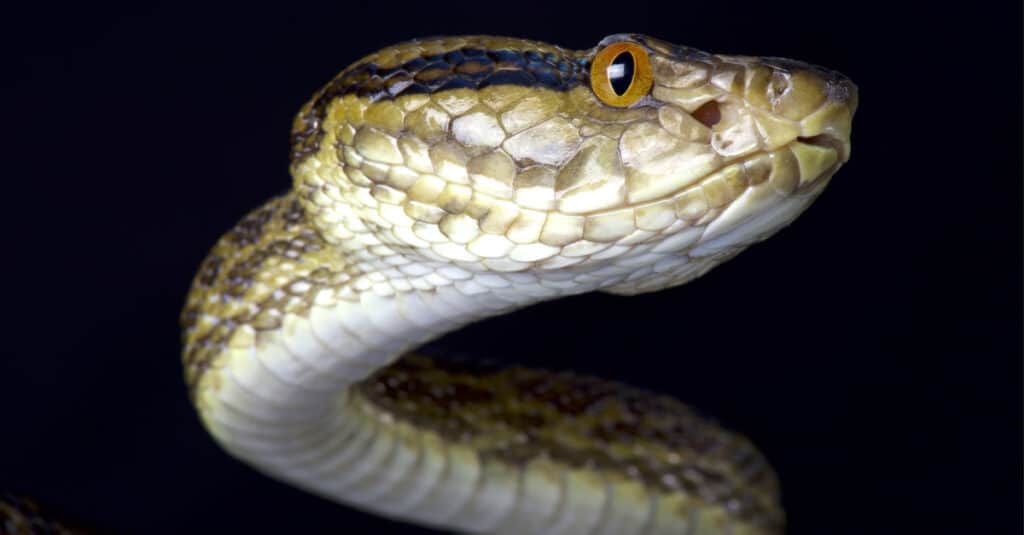
Habus are mostly arboreal, spending much of their lives in the trees. They have large heads and slender bodies.
©reptiles4all/Shutterstock.com
Tzabcan Rattlesnake (Crotalus tzabcan)
This elusive species is carved into Mayan temple walls, and there are even large stone sculptures that depict rattlesnakes that might be the tzabcan. Also known as the Yucatan rattlesnake, the tzabcan rattlesnake is one of the bigger pit vipers and only lives on the Yucatan Peninsula. Once considered a subspecies of the Middle American rattlesnake (Crotalus simus), genetic testing showed that it belonged on its own as a full species — Crotalus tzabcan.
It can be shy, first attempting to escape, but turn around and strike with little warning. Interestingly, the snake begins life with a neurotoxic venom that becomes hemotoxic as it matures. Tzabcan’s diets are as much as 93% rodents like rats and mice, making them vital to keeping those small mammals from overpopulating areas where they live.
These snakes have an unusual adaptation where they flatten out their necks laterally in the face of a threat. Some scientists think it could make a predator misjudge where its head is located, but no one knows for sure.
A large tzabcan rattlesnake can grow up to six feet long. If you compare the size of this pit viper to a standard dog leash, they’re about the same — and these bulky snakes can be bigger around than an adult human’s forearm.
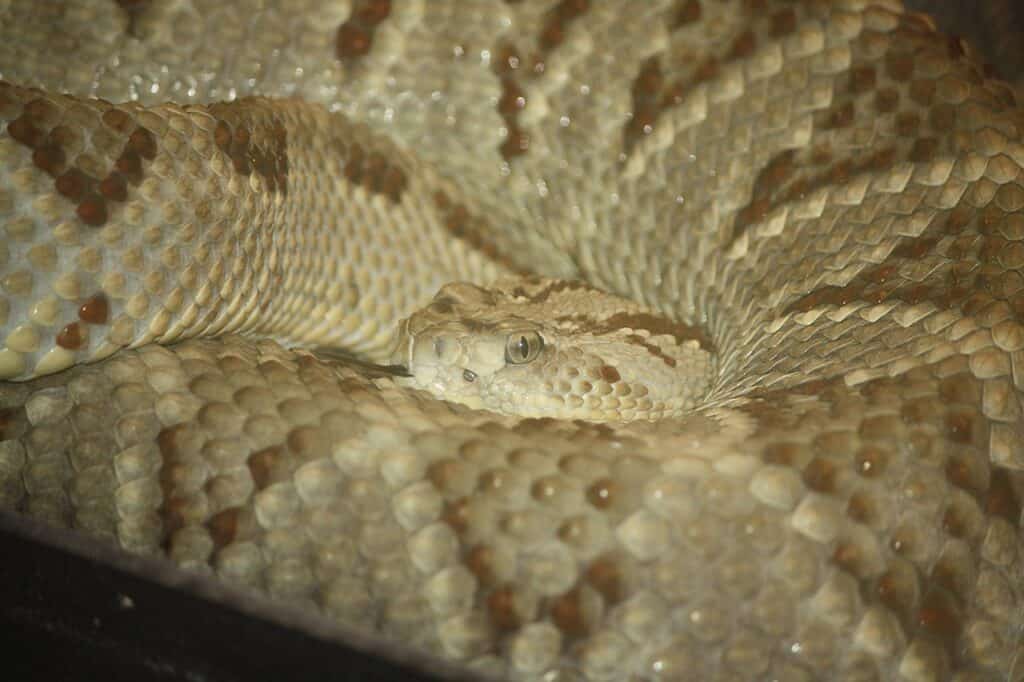
Tzabcan means rattlesnake in Mayan and these snakes only live on the Yucatan Peninsula.
©Ltshears / CC BY-SA 3.0 – License
Eastern Diamondback Rattlesnake (Crotalus adamanteus)
Native to the eastern United States, the eastern diamondback rattlesnake is easily one of the biggest pit vipers in the world. Yet, it’s only the second-longest. Eastern diamondback rattlers are also very heavy and can weigh as much as a toddler at 34 pounds. They’re big and stocky with huge venom glands. How big? Enough to produce 1,000 mg of dried venom, which equates to roughly one-third teaspoon of salt. If that doesn’t sound like much, think about this fact: the estimated lethal dose for a human is about one tenth of what they can produce in one bite.
Now, for size comparisons, because that’s the best way to understand just how big they get, an eastern diamondback rattlesnake can grow as long as two typical four-foot-long park benches. That’s right, eastern diamondback rattlesnakes can grow up to eight feet long. These giants eat mice, rats, and other mammals. Really big individuals can also eat fully-grown rabbits.

Eastern diamondback rattlesnakes’ pattern often fades towards their tail.
©Chase D’animulls/Shutterstock.com
Bushmaster (Lachesis muta)
The bushmaster. Its scientific name means silent death and refers to the fact that this extremely venomous snake doesn’t have a rattle. Its bite has caused hundreds of recorded deaths, but its venom isn’t quite as dangerous as the eastern diamondback’s.
But here’s a pit viper size comparison for you. Imagine three of those four-foot-long park benches and place them side by side, with a bushmaster stretched out. The biggest recorded bushmaster would be about the same length. Some people say they can reach 13 feet, but there isn’t enough evidence to support the idea.
As long as bushmasters grow, they’re still not as heavy as an eastern diamondback rattlesnake, and only top out at about 15 pounds.
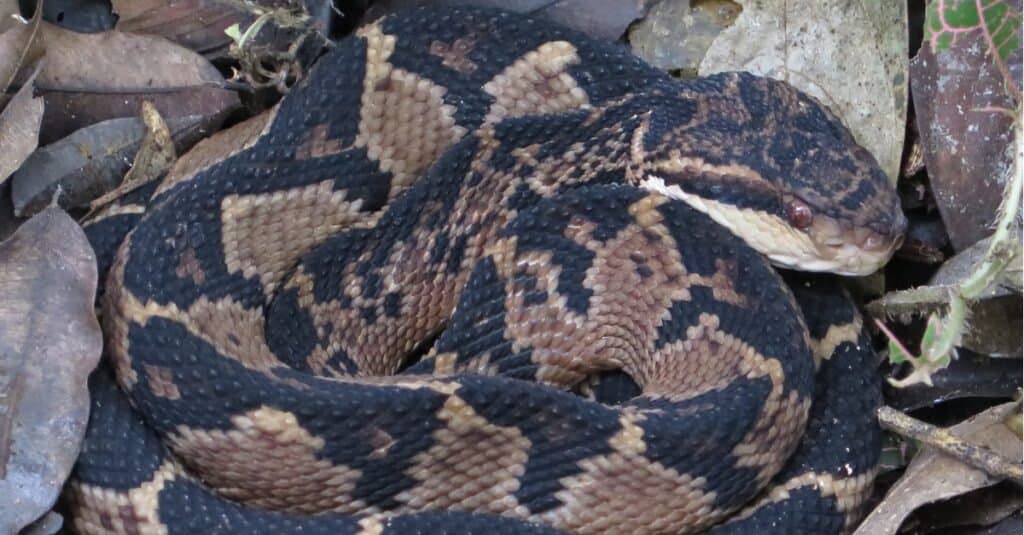
The scales of a bushmaster are strongly raised and feel like a ridge down their spine.
©iStock.com/Luis Espin
Other Big Snakes
Although these pit vipers are big, they’re not actually the biggest snakes in the world — they’re not even the biggest venomous snakes! Take a look at the next few snakes.
Green Anaconda (Eunectes murinus)
Here you go — the heaviest snake in the world. Anacondas are a type of boa native to South America. They live in and around areas with lots of water because their bodies are so heavy that they can’t move comfortably on land. So adults spend a significant amount of their time in the water, waiting for their food.
While other snake species exhibit some sexual dimorphism, green anacondas are the poster child for sexual dimorphism regarding size. Males average about nine or ten feet long, but females can reach astounding lengths and weights. Dr. Jesús Antonio Rivas encountered the biggest verified green anaconda — a female that was 17 feet, one inch and weighed 214 pounds, 15 ounces.
That said, estimates and rumors of even bigger anacondas persist. There are a few historical accounts of larger snakes, measuring as large as 25 feet. The problem with verifying this is how they take the measurements. Snakes are almost all spine, with hundreds of vertebrae, and discs between each. The discs can compress and expand, changing the measurements of a snake by several inches or even feet.
Many believe that green anacondas can easily achieve 25 feet long and 500 pounds.
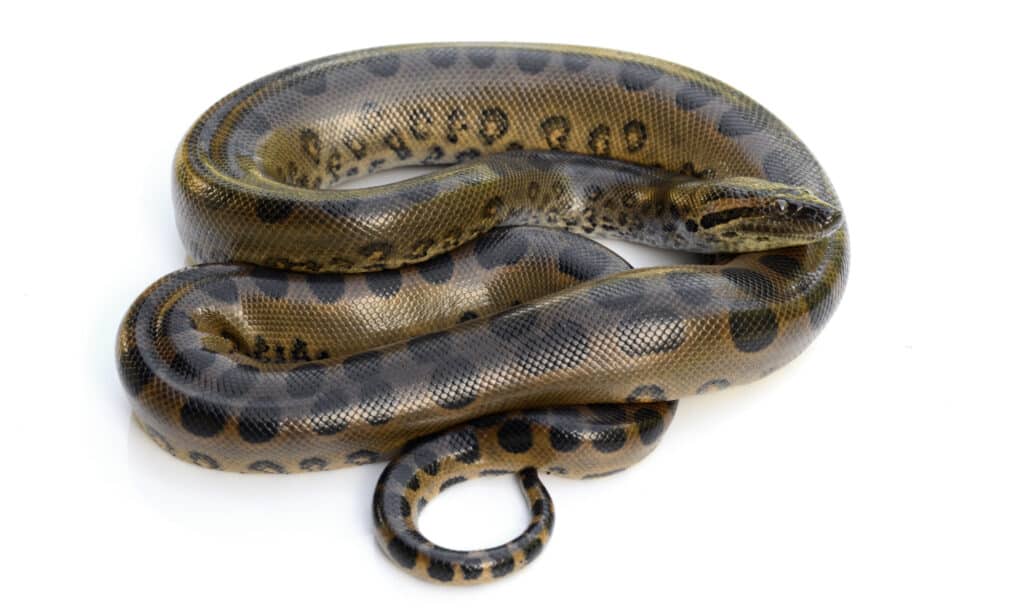
Wild-caught green anacondas are aggressive when in captivity.
©Patrick K. Campbell/Shutterstock.com
Reticulated Python (Malayopython reticulatus)
The longest snake in the world is the reticulated python. Native to south and southeast Asia, these snakes are excellent swimmers that are often the first to colonize new volcanic islands. Reticulated pythons are often spotted out at sea, swimming for who-knows-where.
These snakes regularly exceed 20 feet long. According to the Guinness Book of World Records, the longest snake ever caught was a reticulated python that measured 32 feet, nine and a half inches long. However, the specimen was already dead when they measured it. The length is a bit suspect because a live python’s muscles prevent you from stretching it, but a dead python can be stretched out farther.
Among the living snakes, the longest snake in captivity is a reticulated python named Medusa.

Reticulated pythons are the longest snakes in the world.
©Opayaza12/Shutterstock.com
King Cobra (Opheophagus hannah)
Hail to the king, cobra, that is.
Whenever you see a snake with the word “king” in its common name, you know that it regularly makes meals of other snakes. King cobras are native to south and southeast Asia. They are the longest venomous snake in the world and their favorite meal is other snakes — sometimes even their own species. In captivity, they’ll readily take mice and rats. However, their demeanor changes when they get the chance to have another snake for lunch — many of them seem to perk up.
King cobras average between nine and 12 feet long, but the longest one was a resident of the London Zoo during World War II. It was 18 feet, nine inches long, but sadly had to be euthanized because they had no way to safely house it during the war.

King Cobra (Ophiophagus hannah) The world’s longest venomous snake
©iStock.com/takeo1775
The photo featured at the top of this post is © Jim Cumming/Shutterstock.com
Thank you for reading! Have some feedback for us? Contact the AZ Animals editorial team.






